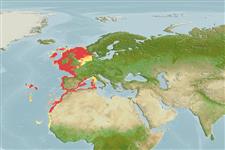>
Eupercaria/misc (Various families in series Eupercaria) >
Labridae (Wrasses)
Etymology: Acantholabrus: Greek, akantha = thorn + Latin, gobius = gudgeon (Ref. 45335).
More on author: Risso.
Environment: milieu / climate zone / depth range / distribution range
Ökologie
seewasser riff-verbunden; tiefenbereich 30 - 500 m (Ref. 2683). Temperate; 62°N - 1°S, 32°W - 11°E
Eastern Atlantic: Norway south to Cape Lopez, Gabon and including Madeira, Azores and the Canary Islands. Also in the Mediterranean and Adriatic seas.
Size / Gewicht / Alter
Maturity: Lm ? range ? - ? cm
Max length : 25.0 cm TL Männchen/unbestimmt; (Ref. 5292)
Dark spot on upper part of caudal peduncle and in the end of the spiny part of the dorsal fin (Ref. 35388).
Adults inhabit coastal waters near rocky or sandy bottoms. Feed on benthic invertebrates. Solitary (Ref. 2683). Oviparous, distinct pairing during breeding (Ref. 205). Males build dish shaped nests and guard the eggs (Ref. 205).
Life cycle and mating behavior
Geschlechtsreife | Fortpflanzung | Ablaichen | Eier | Fecundity | Larven
Oviparous, distinct pairing during breeding (Ref. 205). Males build dish shaped nests and guard the eggs (Ref. 205).
Gomon, M.F. and P. Forsyth, 1990. Labridae. p. 868-882. In J.C. Quero, J.C. Hureau, C. Karrer, A. Post and L. Saldanha (eds.) Check-list of the fishes of the eastern tropical Atlantic (CLOFETA). JNICT, Lisbon, SEI, Paris; and UNESCO, Paris. Vol. 2. (Ref. 5292)
IUCN Rote Liste Status (Ref. 130435)
Bedrohung für Menschen
Harmless
Nutzung durch Menschen
Fischereien: kommerziell
Mehr Information
ReferenzenAquakulturAquakultur ProfilZuchtlinienGenetikElectrophoresesVererbbarkeitKrankheitenVerarbeitungNutrientsMass conversion
PartnerBilderStamps, Coins Misc.LauteCiguateraGeschwindigkeitSchwimmstilKiemenoberflächeOtolithsGehirngrößeSehfähigkeit
Tools
Zusatzinformationen
Download XML
Internet Quellen
Estimates based on models
Preferred temperature (Ref.
123201): 7.1 - 15.1, mean 9.9 °C (based on 356 cells).
Phylogenetic diversity index (Ref.
82804): PD
50 = 1.0000 [Uniqueness, from 0.5 = low to 2.0 = high].
Bayesian length-weight: a=0.00977 (0.00539 - 0.01773), b=3.07 (2.91 - 3.23), in cm total length, based on LWR estimates for this species & (Sub)family-body (Ref.
93245).
Trophic level (Ref.
69278): 3.5 ±0.37 se; based on food items.
Widerstandsfähigkeit (Ref.
120179): mittel, Verdopplung der Population dauert 1,4 - 4,4 Jahre. (Preliminary K or Fecundity.).
Fishing Vulnerability (Ref.
59153): Low vulnerability (15 of 100).
Nutrients (Ref.
124155): Calcium = 17.8 [8.1, 31.7] mg/100g; Iron = 0.211 [0.114, 0.440] mg/100g; Protein = 18.6 [15.7, 20.9] %; Omega3 = 0.494 [0.266, 0.917] g/100g; Selenium = 9.93 [4.54, 21.79] μg/100g; VitaminA = 75.5 [18.4, 368.0] μg/100g; Zinc = 0.662 [0.427, 1.175] mg/100g (wet weight);
